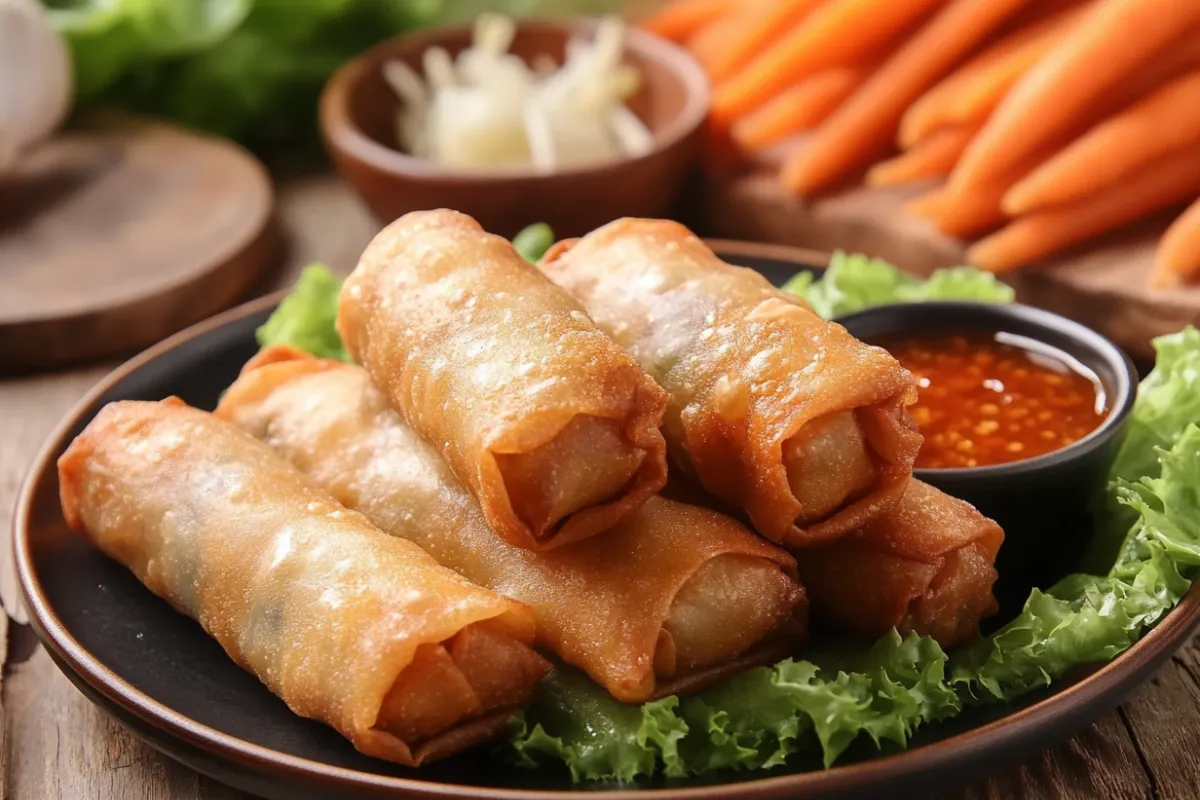Lumpia is one of the most beloved dishes in Filipino cuisine. This Filipino lumpia recipe is perfect for family gatherings, celebrations, or simply a delicious snack. These crispy spring rolls, filled with savory ingredients, are sure to be a crowd favorite. In this guide, you’ll discover different types of lumpia, how to prepare them step-by-step, and tips to ensure they turn out perfectly. Additionally, we’ll explore healthier options like air-fried or vegetarian lumpia, and answer common questions about the recipe.
What is Lumpia?
The Filipino lumpia recipe is a variation of traditional spring rolls, commonly filled with ground meat (usually pork), vegetables, and seasonings. This filling is wrapped in thin pastry wrappers and fried until crispy. While lumpia has its roots in Chinese spring rolls, it has become a cherished part of Filipino cuisine.
There are several variations, such as Lumpia Shanghai—which features ground pork—and Fresh Lumpia, served with a soft wrapper and peanut sauce. For tips on healthy meal preparation using Filipino ingredients, check out Easy Meal Prep Recipes.
Ingredients for Filipino Lumpia Recipe
Here’s what you need to make authentic Filipino lumpia:
- Ground pork (or chicken/beef as an alternative)
- Carrots, finely chopped
- Onions, minced
- Garlic, minced
- Bean sprouts (optional)
- Lumpia wrappers (available at Asian grocery stores)
- Soy sauce, salt, and pepper for seasoning
- Cooking oil (for frying)
For those seeking a healthier alternative, consider using leaner meats or adding extra vegetables. If you’re interested in alternative cooking methods, explore our post on Baking with Greek Yogurt for healthier options.
How to Prepare Lumpia Filling
The Filipino lumpia recipe starts with a well-seasoned filling. Follow these steps to prepare it:
- Cook the ground meat: In a skillet, heat a tablespoon of oil over medium heat. Add the ground pork and cook until browned.
- Add vegetables: Stir in the minced onions, garlic, and carrots. Cook for 3-5 minutes until they soften.
- Season the filling: Add soy sauce, salt, and pepper to taste. Optionally, include bean sprouts or water chestnuts for additional texture.
- Cool the mixture: Once cooked, remove the filling from heat and let it cool. This step prevents the wrappers from becoming soggy during rolling.
Wrapping Filipino Lumpia
Once the filling has cooled, it’s time to wrap your lumpia:
- Place the wrapper flat: Lay the lumpia wrapper on a flat surface with one corner facing you.
- Add filling: Put a tablespoon of the filling near the corner closest to you.
- Roll and fold: Begin rolling the wrapper, folding in the sides as you go to enclose the filling tightly.
- Seal the wrapper: Brush a little water or beaten egg on the farthest corner to seal the roll.
- Repeat: Continue until all filling and wrappers are used.
For creative ideas on adding flavors to your recipes, check out our Ultimate Banana Brownie Recipe.
Frying Techniques for Crispy Lumpia
Getting the perfect crunch is crucial for this Filipino lumpia recipe. Follow these frying techniques:
- Heat the oil: In a deep frying pan, heat enough oil to submerge the lumpia halfway. The ideal frying temperature is 350°F (175°C).
- Fry in small batches: Cook the lumpia in small batches to avoid overcrowding. Fry each side for about 3-4 minutes until golden brown.
- Drain the excess oil: Once fried, transfer the lumpia to a plate lined with paper towels to remove excess oil.
- Serve hot: For the best experience, serve the lumpia immediately while still crispy.
Variations of Filipino Lumpia
Lumpia Shanghai
This version is small and filled with ground pork, making it a perfect appetizer. Dip it in sweet and sour sauce for extra flavor.
Vegetarian Lumpia
For a meat-free version, substitute the pork with tofu or a mixture of vegetables. The preparation remains the same, but the result is a lighter dish.
Fresh Lumpia (Lumpiang Sariwa)
Instead of frying, fresh lumpia is wrapped in a soft crepe-like wrapper and filled with sautéed vegetables. It is usually served with a sweet peanut sauce.
Air-Fried Lumpia
To enjoy a healthier alternative, use an air fryer. Preheat it to 375°F (190°C) and cook the lumpia for 12-15 minutes, flipping halfway through for even crispness.
Dipping Sauces for Lumpia
Here are some popular dipping sauces to pair with your lumpia:
- Sweet and Sour Sauce: A tangy, sweet sauce that complements the savory filling perfectly.
- Garlic Vinegar Dip: This traditional Filipino sauce is made from vinegar, garlic, and chili, adding a sharp and spicy kick.
- Peanut Sauce: Ideal for fresh lumpia, peanut sauce adds a rich, nutty flavor to balance the light filling.
Tips for Perfect Lumpia
Here are a few tips to help you master this Filipino lumpia recipe:
- Keep the filling dry: Moist filling can make the lumpia soggy. Ensure the vegetables are well-cooked, and any excess moisture is removed.
- Use neutral oil for frying: Oils like vegetable or canola work best for frying lumpia as they don’t overpower the dish’s flavor.
- Freeze for later: Lumpia freezes well. Prepare them in advance, lay them on a tray in a single layer, and freeze. Once solid, transfer them to an airtight container for up to three months.
Healthier Lumpia Options
For those looking for healthier alternatives, consider these options:
Baked Lumpia
Instead of frying, bake the lumpia at 400°F (200°C) for 15-20 minutes, brushing them with a light layer of oil before baking to maintain crispiness.
Air-Fried Lumpia
Using an air fryer is a great way to enjoy lumpia without the extra oil. This method results in crispy lumpia with significantly less fat.
Frequently Asked Questions (FAQs)
What is the difference between lumpia and spring rolls?
Lumpia is a Filipino version of spring rolls, typically featuring thinner wrappers and pork-based filling. Chinese spring rolls often use thicker wrappers and a different mix of ingredients.
Can I use rice paper for lumpia?
Yes, rice paper can be used as a substitute for traditional lumpia wrappers. However, the texture might differ, and rice paper is more commonly used for fresh rolls.
How do I prevent lumpia from breaking while frying?
To avoid breakage, make sure the wrapper is sealed tightly. Also, ensure the oil is not too hot, as overheated oil can cause the wrappers to crack.
Can I make lumpia ahead of time?
Yes! You can make lumpia ahead and freeze it. Roll the lumpia, place them on a baking sheet, freeze until solid, then transfer to an airtight container for up to three months.
Conclusion
This Filipino lumpia recipe is a crowd-pleaser that’s easy to prepare and delicious. Whether you prefer the classic Lumpia Shanghai, a healthier air-fried version, or even Vegetarian Lumpia, this Filipino dish is versatile and guaranteed to impress. Pair your lumpia with a variety of dipping sauces and enjoy it hot for the ultimate experience.
For more meal-prep tips and Filipino recipes, don’t forget to check out our Easy Meal Prep Recipes. If you’re craving dessert, try our Ultimate Banana Brownie Recipe for a delightful sweet treat!

